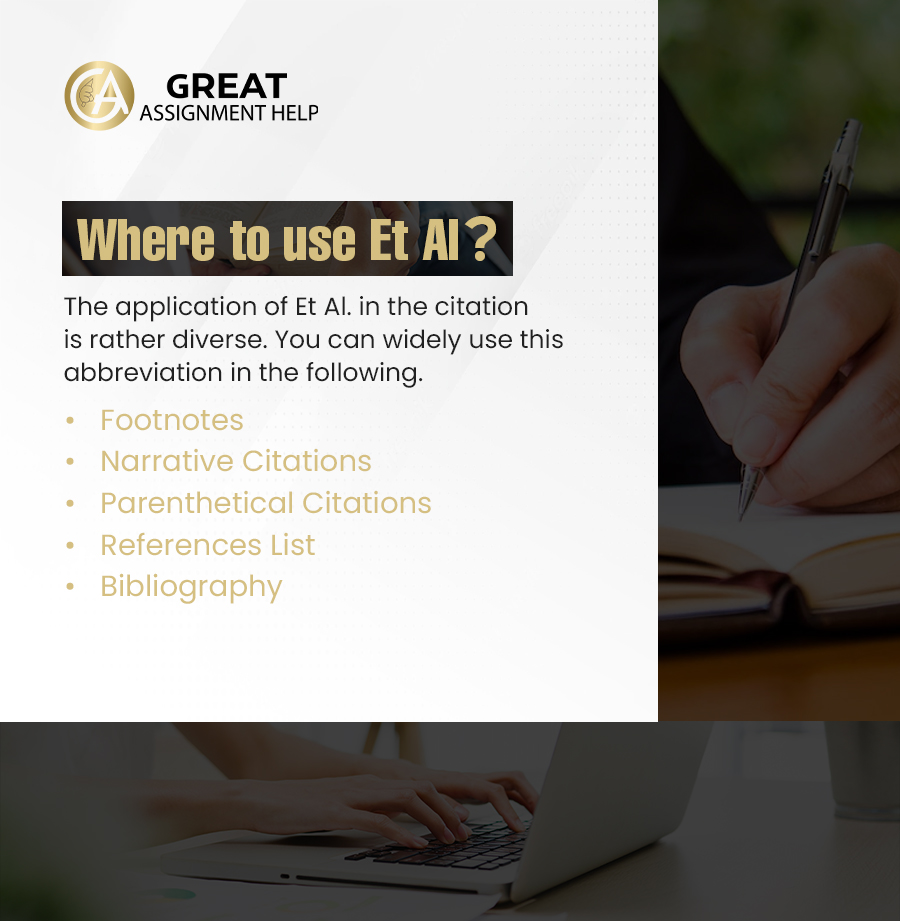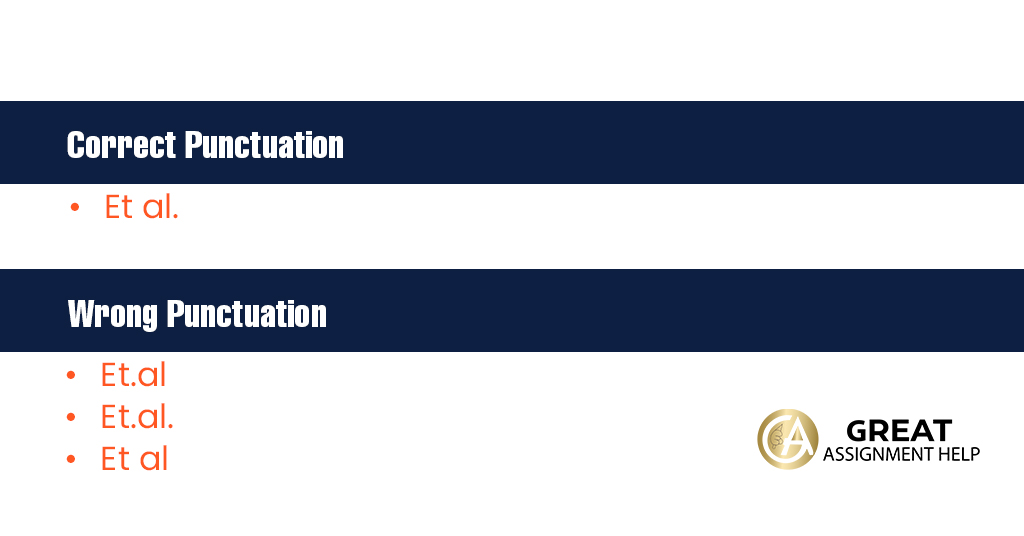In academic papers, generally, a wide range of Latin abbreviations or phrases will be used. One such popular abbreviation is “et al.” If you are a student who is writing a scholarly paper, then to present your research findings as per the writing guidelines, you must be aware of the important Latin abbreviations. Do you know what does “et al.” mean? If you have no idea about it, then continue reading this blog post. Here, with examples, you can learn how to use and punctuate “et al.” correctly in various citation styles such as APA, MLA, and Chicago.
What does Et Al. mean?
“Et Al.” originates from the Latin Phrase “et alia”. Its meaning is “and others”. Mostly, this abbreviation is used in academic papers when researchers refer to multiple authors or other creators of a particular work.
When Should You Use Et Al.?
You can use it rather than a long list of authors and format your writing in the manner of formal academic papers. For instance, some peer-reviewed articles will have more than 20 authors contributing to the work. In such circumstances, adding each author’s name to the list will require additional paragraphs. Your paper will most likely exceed your supervisor’s word count if you do this. Additionally, the lengthy in-text citations will primarily disrupt the reading flow, making it difficult for your readers to distinguish. Therefore, scholars prefer to use abbreviations to cut down on the length of footnotes and in-text citations.
The primary goal of it is to assist readers in finding the piece. This is the recommended format for in-text citations in almost all citation styles. In addition, citation styles like MLA make use of the phrase while listing the references.
Where Should You Use Et Al.?
You can widely use this abbreviation in the following citations.
- Footnotes
- Narrative Citations
- Parenthetical Citations
- References List
- Bibliography
How Should You Use Et Al.?
In general, you can use this Latin abbreviation, if you need to cite a work with a lengthy list of authors that exceeds three or more. Are you worried about how to use et al in your academic paper? It’s simple! Just write the name of the first author and substitute the remaining people who have worked on the cited piece with the abbreviation. In case, you totally have three authors and have already written the names of two authors, in such a situation, it is wrong to use the short form to refer to the third author because the abbreviation is plural.
Each referencing manual follows certain rules regarding the usage of “et al.” Below we will discuss how to punctuate it correctly.
As mentioned earlier, “et al.” is an abbreviation of “et alia”. Here, the only way to punctuate it is by using a period after “al” to specify that it is an abbreviation of “alia”. However, you can also use other appropriate punctuation marks after “et al.”
For instance, when you use the abbreviation in the middle of a sentence or an APA in-text citation, you can also use other punctuation marks like a comma.
Example:
- According to Jayesh et al. Yoga improves the quality of health and life of cancer patients who undergo radiotherapy.
Note that, you need not add another period if you use the abbreviation at the end of a sentence.
Example:
- It is mentioned after analyzing a group of patients from a certain hospital, stated Jayesh et al.
For your better understanding, below we have specified the right and wrong usage of “et al.”
Difference between Et Al. and Etc.
Often, some people confuse “et al.” with “etc.” in a certain context. Remember, if you are using a Latin phrase or abbreviation in your academic paper, then prior, you must have a strong knowledge of its meaning and usage.
As explained earlier, “et al.” means “and others”, and it is widely used in relation to people. But on the other hand, “etc.” or “et Cetra” predominantly works well for phenomena and objects because its literal meaning is “and other similar things”.
Look at the example listed below and learn the difference between et al. and etc.
Example:
- It might be a result of metallic reactions, chemicals, etc. (Richard et al., 2009).
Et Alibi: Another Expression of Et Al.
“Et Al.” can be an abbreviation for a number of other word or phrase families. The Latin expression “et alibi,” which is also shortened to “et al,” Although “et alibi” and “et alia” is not as frequently used in academic writing, you can still recognize them in certain situations. Due to the numerous instances, it appears in detective films, the term “alibi” is not particularly difficult to remember. In other words, an alibi is evidence that a suspect could not have committed the crime because they were elsewhere at the time. “Elsewhere” is the keyword in this case.
“Elsewhere” is meant by “et alibi.” In most formal papers, it is usually used to show that the cited information appears in more than one place on a particular page or passage of a text.
Et Al. Examples in Citation
In order to help you gain a better understanding of how to use the Latin phrase in academic papers, below we have shared some simple examples. Check it and get to know its usage in the in-text citations of several styles.
APA Citation Example
- According to Albert et al. (2020), it is a result of the link between discrimination and identities associated with nationality and religion (p. 12).
Parenthetical Citation Example
- (Albert et al., 2020, p. 12).
MLA Citation Style Example
- Albert, Brown, et al. Identity Crisis: The 2018 Head of the State Campaign. Stanford University Press, 2020.
Read More – What is the Differences Between APA vs. MLA
Et Al. in APA Style
In this section, let us see how to use “et al.” while formatting your paper as per the APA style of different editions.
APA 7th Edition
APA 7th edition is the latest edition of the APA style. Particularly, in this style, you can use the short form only when you are about to cite more than two authors in the text of your work. Such in-text citation, that is either parenthetical or narrative should specify the first author and refer to others with the abbreviation following the first name. As this abbreviation is plural, you should use it only to substitute two or more names.
Here is an example that will show you how to cite an article with four authors.
- Stephen, E., Bailey, E. J., Edward, H., & Olivia, J. (2020).
The in-text citation for this source can be cited in the following way.
- (Stephen et al., 2020)
Remember, here no punctuation mark is required between the scholar’s name and the Latin phrase.
In case, there are multiple authors with the same last name or several works by the same author, in order to avoid confusion, you should list different authors. For example, let us consider that you need to cite two different articles with such a list of creators in your analytical essay.
- Jennie, K.C., Arthur, C., Boris, S., Becky, S., Davidson, K., Tovino, A., & Sahil, M. (2019).
- Jennie, K.C., Sahil, M., Davidson, K., Tovino, A. (2019).
Both articles were published in the year 2019. Hence, you cannot list only the first surname as an APA in-text citation for the two identical sources. In such a scenario, you can mention two or more authors by using a comma to separate the names and the Latin phrase. For example
- (Jennie, Arthur, et al., 2019)
Remember, the short form can be used only when you need to show your readers that there are several other creators. Therefore, if you have several works by the same author, then the articles with only three authors will list all of them. Instead of an abbreviation, an APA in-text citation will mention the name of the third author.
- Jennie, K.C., Heber, C., Davidson, K.G. (2019).
- (Jennie, Heber, & Davidson, 2019)
According to APA style, it is not recommended to use short forms in the references list. Instead, you should write the names of all the authors. Especially, if the list has more than 20 authors, then place “…” after the 19th name and add the final author’s name.
APA 6th Edition
Even though the 7th edition has arrived, some professors haven’t moved from the APA 6th edition. So, here, we will let you know how to use the Latin abbreviation for “and others” in essays and other scholarly articles as per the 6th edition of APA. The major difference between both editions is that, if you have nearly three to five authors, then you should include them all in the first in-text citation. However, in all the other subsequent citations, you need to specify only one author that is listed first in the original author list of the cited work.
First in-text citation:
- (Syed, Sharon & Williamson, 2019)
Subsequent citation:
- (Syed et al., 2019)
In case, the cited work has more than six authors, then use the short form in all in-text citations, even in the one that is present at first.
- (Razi et al., 2020)
Et Al. in MLA Style
Even in MLA style, using “et al.” is a common trend. Well, if you cite an article, book, or any other work that is prepared by three or more authors, then you can use the Latin phrase after the last and first name of the scholar who comes at the start of the authors’ list.
- Allen, Charles, et al. Developing Personality in and Around Institutions. Harvard University Press, 2015.
The in-text citation of MLA also has a similar format. In order to save space, you should list only the first scholar and substitute other authors with the abbreviation.
- (Allen et al. 23)
Avoid using additional punctuation to separate a page number or “et al.”
Et Al. in Chicago Style
If you have nearly one to three scholars, then in Chicago or Turabian style, you should specify all the scholars. However, the footnotes for sources that contain four to ten scholars need the short form after the first scholar’s name. Note that, the bibliography should include all the authors’ names without the Latin abbreviation.
Footnotes:
- Tina Elizabeth et al., eds., Ethics in Health Care, 6th (St. Louis MO: Elsevier, 2020), 196.
Biography:
- Elizabeth Tina, Evan Perez, Meg Shelley, and Emma Dickinson, eds. Ethics in Health Care, 6th St. Louis, MO: Elsevier, 2020.
However, if the total number of scholars is much longer and exceeds ten, then add only the names of the first seven authors in the bibliographic entry and substitute others with the abbreviation. For instance:
- Taylor, Brian, Sarah Ronald, Sean Meg, David Cregg, Mark Walsh, Michael Coen, Glenn Kenny, et al., “Challenges of living with Mood Disorder in Adults” BMJ Open 4, 10 (2013): e007374.
The Bottom Line
We hope you are now aware of how to use “et al.” Mainly, by using this Latin phrase you can give credit to a lengthy list of authors without naming them. Besides the references list, you can also apply the scholarly abbreviation in the foot and endnotes. In case, you are unsure of how to use it in your research paper, call us immediately. The academic writers on our platform have strong knowledge of various citation formats and styles. Therefore, it is more convenient for them to offer great assignment help at a nominal cost. Moreover, by availing of our online assignment writing services, you can get assistance to format, structure, and cite your research paper or scholarly article as per the writing guidelines shared by your instructor or university.
Instead of pressurizing yourself, just book your order and earn extraordinary academic benefits by making use of our assignment writing service.





